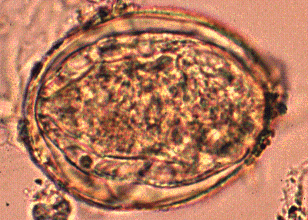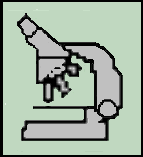CRYPTOSPORIDIUM PARVUM:
The Elusive Parasite in America's Drinking Water
General Disclaimer
This Web project was developed as part of "Internet Resources" courses offered by the Biology and Geology departments of the California State University, Los Angeles in 1995 and 1996. It was submitted to the instructors for evaluation and then placed on-line by the Electronic Desktop Project (EDP). EDP does not update or maintain any of the material of this project, and does not vouch for validity or correctness. Furthermore, the student developing this project was instructed about the rules of copyrights. EDP can in no way be responsible for the inclusion of copyrighted material within this project.
Cryptosporidium is a minute coccidian parasite with worldwide distribution. Although the first reported description of the parasite was in 1907, it was not until 1976 that it was known to cause disease in humans. The twenty species of Cryptosporidium that have been described are infectious in mammales, reptiles, birds, and fish. Recent information also supports previous suggestions that cryptosporidiosis is a zoonosis, is not host specific, and is transmitted via the fecal-oral route. The only is species known to infect humans is Cryptosporidium parvum. This species can be transmitted in many ways, including contaminated food, but large scale infection is possible by drinking water contaminated with the parasite. Recent outbreaks have focused a new attention on this imfamous protozoa.
Basic Biology
 Cryptosporidium takes on many different forms during its life cycle. The only one that can be observed, except by autopsy, is the oocyst. Oocysts appear as refractile spherical bodies, ranging from 4 to 5 um in size. Dark granules are often seen embedded within the oocyst.
Cryptosporidium takes on many different forms during its life cycle. The only one that can be observed, except by autopsy, is the oocyst. Oocysts appear as refractile spherical bodies, ranging from 4 to 5 um in size. Dark granules are often seen embedded within the oocyst.
Infection begins with the injestion of the sporulated oocyst, a stage that may remain viable for prolonged periods of time in the environment. Once in the body, the parasite attacks the epithelial cells, where they begin two asexual generations. The resulting sporulated oocysts contain four sporocysts each, which are released with the feces. Here is a more detailed description of the life cycle.
Clinical Disease
Cryptosporidiosis is a zoonosis. The first human case reported was in 1976. The clinical symptons of Cryptosporidiosis includes nausea, fever, abdominal cramps, anorexia, five to ten watery, frothy bowel movements a day. While some patients may exhibit the above symptoms, others have relatively few symptoms.
The duration and severity of the disease depends on the immune status of the patient. In the immunocompetent patient, the disease is self-limiting, lasting about two weeks. But the immune deficient patient will suffer severe symptoms, that will become progressivly worse with time. In such cases, the parasite is not limited to just the lumen of the intestine. There have been reports of Cryptosporidim found in sputum, in lung biopsy material, and in the biliary tract.


Diagnosis
In the past, diagnosis has often been done by microscopic examination bowel biopsy. Because the technique proved not to be reliable, diagnosis is now done by looking for oocysts from fecal material using a flotation method.
The Enterotest has also been used to recover oocysts.
Organisms will stain with: 1) Hematoxylin and eosin 2) Masson's stain 3) Modified acis-fast stain
Sputum specimens from immunodeficient patients with undiagnosed respiratory illness should be submitted in 10% formalin and ezamined for Cryptosporidium oocysts by using the same techniques as used for stool samples.
The use of monoclonal antibodies has proven to be ver helpful in providing a more sensitive method of detecting organisms in stool specimens.
Treatments
At present, there is not effective treatment for cryptosporidiosis. Tissue culture systems and animal models that support the entire life cycle have been developed and may provide opportunities for in vitro drug studies. Any data so far have been inconclusive. Preliminary data indicate that paramomycin may be a potential therapeutic agent for clinical trials. Ongoing studies with immunologic intervention hold promise but are not widely used.
A potentialCryptosporidiosis drug will be clinically tried.
Epidemiology and Prevention
Cryptosporidium parvum is spread by many methods...
Animal-to-human transmission most often occurs in uran setting when people come into contact with calves. Infection is often accompanied by gastroenteritis.
Human-to-human transmission is likely to occur through direct or indirect contact with stool material. Children often spread the disease in daycare centers. The elderly contract the diesease in nursing homes. It can also be spread by sexual practices involving oral-anal contact.
Water contamination has proven to be a significant risk factor with the disease. The oocysts are resistant to current water treatment methods and disinfectants, including chlorine. For more information on water contamination and treatments, click here.
Here is a good site for a discussion of preventive measures.

Current Research
The following has been added by the Electronic Desktop Project:
 Contact Us
Contact Us
Please take a few minutes to send us your comments and suggestions. We read every message and try to respond promptly to questions. Your feedback will help us improve our project.
If you are an educator who is using our NEXTSTEP or virtual applications in the classroom, we would especially like to hear from you. Let us know what you are doing and how it is working out. Continued support for this project will depend on its impact in science education.
If you are an educator who is interested in making use of our NEXTSTEP or virtual applications, please let us know how we can help.
Other Places To Go
 Return to the Electronic Desktop Project home page
Return to the Electronic Desktop Project home page
 Check out the WWW Virtual Application Catalog from the EDP
Check out the WWW Virtual Application Catalog from the EDP
 Check out the NEXTSTEP Application Catalog from the EDP
Check out the NEXTSTEP Application Catalog from the EDP
 Visit the home page for California State University, Los Angeles
Visit the home page for California State University, Los Angeles
 Cryptosporidium takes on many different forms during its life cycle. The only one that can be observed, except by autopsy, is the oocyst. Oocysts appear as refractile spherical bodies, ranging from 4 to 5 um in size. Dark granules are often seen embedded within the oocyst.
Cryptosporidium takes on many different forms during its life cycle. The only one that can be observed, except by autopsy, is the oocyst. Oocysts appear as refractile spherical bodies, ranging from 4 to 5 um in size. Dark granules are often seen embedded within the oocyst.





 Contact Us
Contact Us Return to the Electronic Desktop Project home page
Return to the Electronic Desktop Project home page Check out the NEXTSTEP Application Catalog from the EDP
Check out the NEXTSTEP Application Catalog from the EDP Visit the home page for California State University, Los Angeles
Visit the home page for California State University, Los Angeles